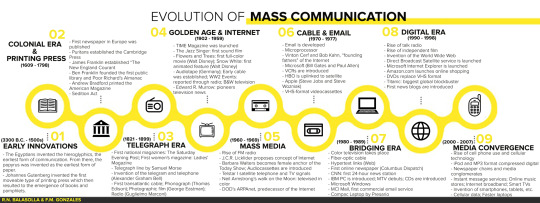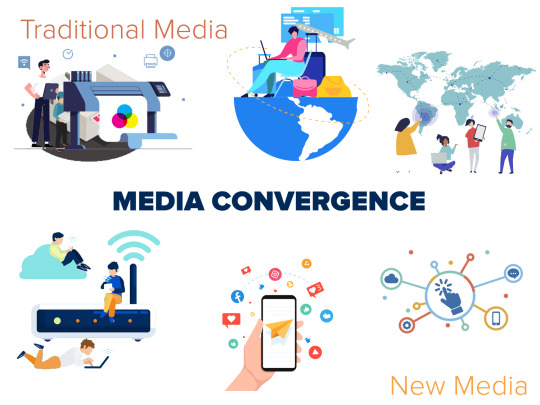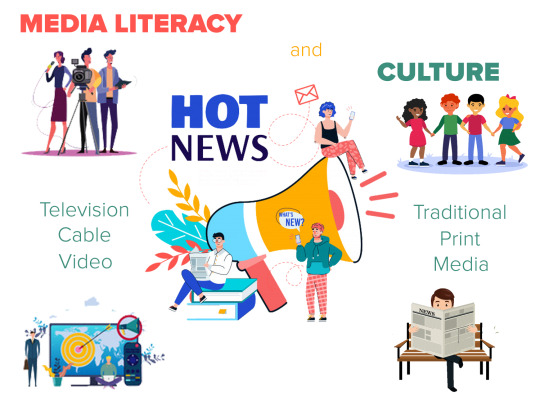Text
Summative Assessment (Module 1)
MEDIA TIMELINE

Five Points of Change in Mass Communication
The biggest leaps in mass communication would be the following:
a.) Oral to Paper, Print
Stories were only shared through songs and chants. Knowledge was passed down to generation after generation - but what happens when that generation dies? The use of paper as a form of mass communication has made it possible for us to document events through writing, and later on, to printing. Paper was heavily used throughout this period as it is accessible and easy to use, and even up to now - paper is still used everywhere. It is, no doubt, the most used form of communication even in this digital setting.
b.) Print to Telegraph
Even if paper/print is still widely used up to today, there are still limitations to its power such as the speed of delivery. Innovators thought of different mediums to transmit information quicker and faster, and that is where the inventions of the signal devices came forth such as the television, telephone, and radio. In the height of civil wars and conflicts, the telegraph proved its power to deliver signal messages quickly than paper. It is through these devices that brought the foundations.
c.) TV to Mass Media
Innovations never stopped here. The birth of the television only made it possible for tech developers to widen their scope and thus - the emergence of other forms such as the cassette tapes, DVDs, and the like. It is also in this period where they realized the capacity of the TV to inform the masses with the news and similar shows. Mass media also moved on from the common black and white format to color.
d.) Mass Media to Digital Era, Internet
The invention of computers and the establishment of the Internet has made it possible for our mass communication to bridge the gap between what was the present, to the future. What was only heard on the cassettes and CDs were now available on the online space. News publications started to move to the internet, more specifically the media corporations in much more progressive countries. Everything was suddenly on the internet - including the way we communicate and interact.
e.) Digital Era to Media Convergence
Inventors and tech-savvies didn't stop in the digital era. With media convergence, everything is now within our reach. Information, news,
music, movies, and all sorts of entertainment are now within our thumb's reach. We can now simultaneously consume media without having to spend more and more. Media convergence has made it possible for us to reach each other further and better.

0 notes
Text
Module 1: Activity 3
MEDIA CONVERGENCE

Guide questions:
1. What constitutes a convergent media? How is it differentiated from traditional media? Would you consider convergent media under the categories of new media?
2. How do convergent media empower individuals to assert themselves in the bigger society?
3. Compare and contrast the evolution of communication from orality to literacy and the evolution of media from traditional media to convergent media. What could be assumed (or predicted) for the future of media production and consumption and/or mass communication?
Media convergence is the synthesis of various media and communication outlets such as printing press, television, radio, and most especially, technological companies and the internet. The main goal is to provide a dynamic and flexible experience. Aside from this, it has also become extremely relevant for networks and companies in the modern age of television to heavily rely on convergence in their marketing tactics. Traditional media is more on the “non-electronic” part of the history of media, meanwhile, convergence of media leads to the growth of conventional and digital media. New media may be considered as part of media convergence. One of the most famous online encyclopedia, Wikipedia, is an example of new media whereas it merges different web-links, digital text, and videos in one website.
Convergent media allows each media to be available just within a consumer's reach. With this advancement, it made it possible for us to consume media simultaneously. We can watch movies, at the same time, still be updated with the week's happenings on the news through push notifications enabled by our smartphones. Songs that were only played through a CD can now be streamed in multiple platforms such as Spotify or Apple Music.
Media convergence helped our society control the narratives of one another. It has put the spotlight on us, as individuals, to tell our
stories. We can now debunk statements, verify the truth, and have collective discussions on matters that affect us. It has empowered us to also become a player in what was a confined space that was heavily controlled by the rich and powerful. Recent events, such as the #BlackLivesMatter Movement, were heavily powered by social media protests. Alongside with this, celebrities and athletes see to it that this movement should be recognized by their fans or viewers. An example of this would be the display of this protest by the athletes of the NBA or National Basketball Association throughout this season.
This technological advancement has indeed put forth the individuals as the main story tellers. It has empowered us, and will empower more in the years to come as more innovations are being placed.
Orality delivers messages more faster than literary communication. Participants can also converse face-to-face with clarity, and can initiate more thoughtful discussions through asking questions. Although, this communication can quickly fade in time as it can be not documented.On the other hand, literary communication urges us to think critically with the information in hand. It is also much more clear since the message is thought out more and not out of impulse, comparing it to oral communication. The information through literary communication can be passed down to more generations to come because it is documented.
The downside of literary communication would be its lack of clear engagement among participants.
Aside from the aforementioned, we can also compare the evolution of media from traditional media to convergent media. Traditional media is comprised of the printing press, newspapers, magazines, radio, and the television (which is still being used today). The convergence of media made it possible for traditional media to be more innovative and digitized. What can only be read in the paper before is now just a few clicks away in your smartphone or any digital device. Due to this, there's now a wide array of media forms that we can consume thanks to media convergence - from old vintage films, to interactive news stories.
With the present reality in mind, we can assume that there is more to come for our future media users. We can predict that search engines will be more precise and concise with the information you are looking for. With more and more publishing companies shifting to digital content, we can predict the end of newspapers and radio companies soon enough since we are more
dependent now on technology that brings us ease and comfort. At the end of the day, even with these optimistic changes and developments with our communication and media-consumption, we can predict that there will be more disadvantages with everything just being "one click away."
0 notes
Text
Module 1: Activity 2
EVOLUTION OF MEDIA, DIGITIZATION, AND MEDIA ACCESSIBILITY

Guide questions:
1. What are the industrial or economic factors in the evolution of media from print to radio to television?
2. What does the digitization of videos mean for information producers and consumers?
3. What are the pros and cons of media accessibility?
We have seen drastic changes in the evolution of media. What was just a far-fetched future before has already become our very own. Print media was later on replaced by broadcast media, which then, was also replaced by digital media. The changes in media were heavily attributed by the various technological advancements through modernization. It is our desire to live with comfort and ease which then motivated us to innovate further and better with the existing technology that we have.
We also saw a great opportunity to monetize (hypercommercialism) media further by having commercials or advertisements in between. Since then, TV Shows such as our local noontime shows, become avenues of commercialization and advertisement with products being featured left and right, depending on the target audience. Through this, the networks earn more alongside with TV personalities who feature these brands and products being featured.
Digitization is “the process of converting information into a digital format.” (Rouse, 2007) Through digitization, we were able to uncover the advantages, along with its disadvantages, in terms of sharing and producing content in digital form.
For producers, digitization means sharing information with much more ease. A lot of our media corporations have adapted digitizing their content such as newspapers and magazines. The likes of Philippine Star and The Daily Inquirer have already started delivering the news through social media accounts and their own established websites. Magazines, such as the Summit Media Publishing, have already digitalized majority of their content two years ago.
For the consumers like the masses, digitized media becomes more accessible and more personalized. The various available media platforms, such as streaming sites, have made our interaction with media more engaging with our own interests. We can also tailor the information we receive and disconnect ourselves from information we do not find interesting.
Like all things, there are pros and cons when it comes to ease of media accessibility. The brighter side of this would be the ease of information-gathering on the part of the consumers. We can not only access information locally, but also internationally as more and more foreign news resources become available to us. Students and learners alike can now access information sourced from different parts of the globe in order to help their education and learning.
On the other hand, even with these optimistic innovations, media can still be abused and used to harm the people and disseminate wrongful information. The ease that came with digitalizing information is that it can be edited, such as the likes of Wikipedia. If we are to use digital media with wrongful intentions, we are yet creating another unsafe space of information exchange.
0 notes
Text
Module 1: Activity 1
ORALITY AND LITERACY

Guide Questions:
1. What are the differences between primary oral cultures and literary cultures? How are they related with each other?
2. What does Walter Ong mean by the intersubjectivity of communication? How does this differentiate communication from media?
3. How does the ‘media’ model of communication show chirographic (i.e. writing) conditioning?
Back then, our ancestors passed traditions and beliefs to generations by oral communication; as time passed by, those people created their own “alphabets” in order to preserve those ethnicities. A community is born when these efficient, progressive, and constructive interactions become more cohesive, and it is all because of communication. Literary cultures originated in oral cultures. Every piece, poem, prose, and chants were from oral culture. While primary oral cultures transmit knowledge through speech, literary cultures impart data through written or printed media.
Ong said “in all the wonderful worlds that writing opens, the spoken word still resides and lives.”. This quote, it already defines how these two cultures are interconnected. Both oral cultures and literary cultures share a big part in the evolution of communication. In addition, they both enable individuals to interact with each other.
According to Walter Ong, intersubjectivity of communication is two or more like-minded people collaborating and they can easily understand each other by smoothing out the contact process by this means.
Intersubjectivity involves human involvement in communication. In order to avoid any miscommunication and misunderstanding, it is a must that the communicators are on the same page; it is important to ensure that messages are received as intended. Think of it like a pair of shoes; it wouldn't fit if the other pair were not attached.
Meanwhile, media has a broader range. The sender and receiver wouldn’t be able to discourse an argument or discussion. Some examples of this could be newspapers, magazines, and tabloids.
According to Ong, by making communication text-based, the communication media model demonstrates chirographic conditioning. First, chirographic cultures regard speech as more clearly informative since it is first written; thoughts are structured before it is oralized. Secondly, the written text appears to be a one-way information sheet; there is no need for a receiver to be present when the text takes shape.
0 notes